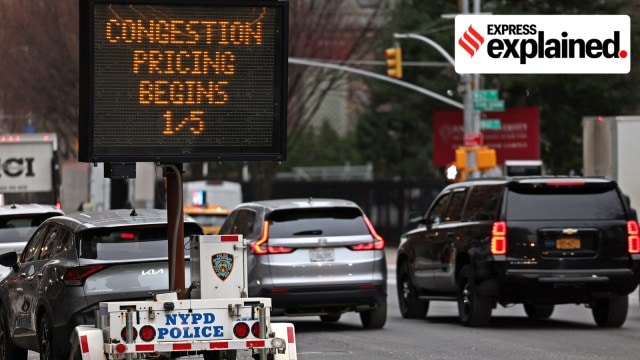New York introduced congestion pricing for its city centre. Can such a plan work in India?
How have cities around the world sought to clear clogged roads? What advantages does congestion pricing offer, and how can governments sell the idea to citizens?
 Vehicles pass a sign on 9th Avenue announcing New York City's congestion pricing program on January 6, 2025. (REUTERS/Mike Segar)
Vehicles pass a sign on 9th Avenue announcing New York City's congestion pricing program on January 6, 2025. (REUTERS/Mike Segar)On January 5, New York City became the first city in the United States to implement congestion pricing in an attempt to decongest roads in traffic-dense areas.
Drivers entering the central business district of Manhattan will pay $9 (approx Rs 775) during peak hours. In 2023, NYC had one of the highest traffic delay times among the world’s cities.
Similar initiatives have been implemented in Singapore (since 1975), London (2003), Stockholm (2006), and Milan (2008). Its success, however, depends on cohesion among departments, groundwork, and building awareness.
Which other countries have this system, and how is it implemented?
There are multiple ways in which congestion pricing/ charging programs work in central areas of large cities. It is mostly an electronic toll system, with the charge varying from city to city.
In NYC, drivers will pay through an E-ZPass, while in London, a daily fee of £15 (approx Rs 1,600) is levied.
In Stockholm, the charge varies depending on time and season – SEK 135 (approx Rs 1,045) during the high season and SEK 105 (approx Rs 800) during off season.
Milan also has a pollution charge that varies based on a vehicle’s emission class, though every car entering the central zone must pay €5 (approx Rs 445) a day.
Singapore introduced the Area Licensing Scheme in 1975, but replaced the system with the Electronic Road Pricing (ERP) programme, where drivers are charged each time they enter the congestion zone. Cars can be charged between SGD .50-3 (approx Rs 30-187). Charges go up and down based on traffic and season.
What specific benefits are expected when a congestion charge is levied in a city?
The charge brings city councils and municipalities revenues, as well as environmental and quality-of-life benefits.
ECONOMIC IMPACT: The Metropolitan Transportation Authority in NYC hopes congestion pricing will earn it $15 billion in revenue, which will be used to upgrade transport infrastructure, from old subways to railway lines.
By 2006, Singapore had an annual revenue of $50 million from congestion pricing, which meant the ERP had paid for itself.
REDUCING POLLUTION LEVELS: According to the global climate action group C40 Knowledge Hub, London’s air quality has improved more than five times compared to the UK’s national average, and nitrogen oxide levels have halved since the congestion pricing mechanism was implemented.
In Milan, the congestion charge, called the Eco Pass, is estimated to have reduced carbon pollution by about 30 per cent.
While 50% of Milan’s population takes public transport, the city still has one of the highest European rates of car ownership.
BETTER QUALITY OF LIFE: In an interview in 2019, nearly a decade after the congestion pricing was implemented in Stockholm, Gustaf Landahl, part of the city government at the time, said, “People drove through the city much quicker. Those who took buses noticed they ran on time. People in the city noticed a difference in noise and air quality.”
Traffic levels stayed down at 25%, surpassing the original targets of 10% to 15%, IBM, the company that played the key role in implementing the toll system for the city, said in a report.
Most of the cities that have implemented this program have seen a reduction in both accidents and traffic congestion.
Could congested Indian cities benefit from such a policy?
Shreya Gadepalli and her team at Chennai-based Urban Works Institute (UWI) have carried out surveys in Mumbai to explore congestion pricing in the city.
Their 2020 report, ‘Road Pricing to Decongest Mumbai’ spotlighted advantages that would accrue from the policy, as also some obvious challenges. The report suggested city-specific solutions, and flagged differences between the situations in Mumbai and Singapore – while Singapore has 0.71 million private vehicles for a population of 5.61 million (2017), Greater Mumbai has 12.4 million people and 2.7 million private vehicles.
Gadepalli said congestion pricing could be an effective way to ensure that those who can pay get traffic-free roads, while those who are not willing to do so, benefit from better bus and train systems.
“Our survey in Mumbai showed that those who take public transport already have cars, but they use trains because it gets them to their destination faster. In India, buses can provide almost doorstep service. But they are stuck in traffic – and unless you clear traffic, you can’t make buses desirable,” Gadepalli said.
She underlined the importance of better communication to sell the idea of congestion pricing. “Can governments and municipalities position this idea of congestion pricing as a win-win? Can they upgrade the number of buses, for instance, as a better alternative?
“Rather than a penalty [on cars], the levy should be positioned as a decongestion price for a traffic-free road. The government can show the path, and ensure everyone has an efficient transport alternative,” she said.
- 01
- 02
- 03
- 04
- 05






































